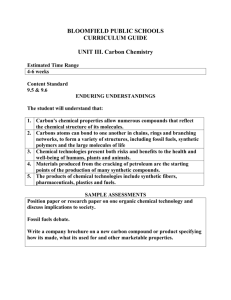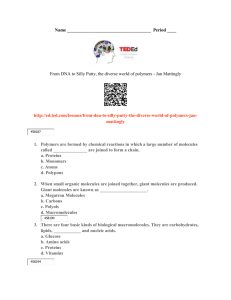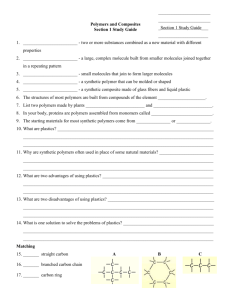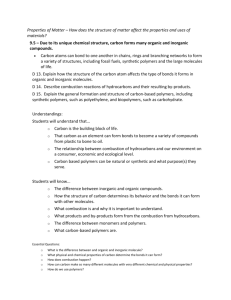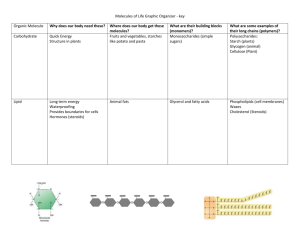P L C OLYMERS AND
advertisement
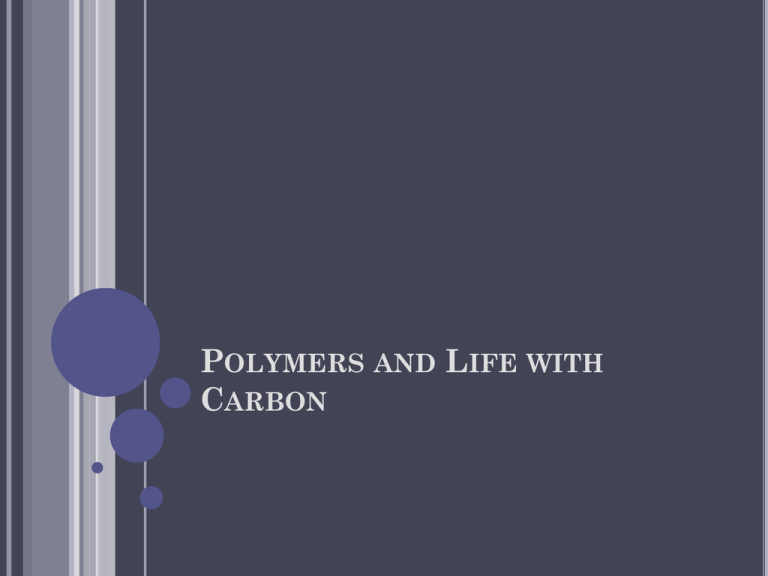
POLYMERS AND LIFE WITH CARBON POLYMERS Polymers are large complex molecules built from smaller molecules joined together in a repeating pattern. Most polymers contain the element Carbon. Carbon can form large molecules because: 1. it can make 4 covalent bonds 2. carbon can form straight chains, branched chains, and rings. Ex of Polymers: DNA, cotton, plastics, polyester, nylon, starch, protein, carbohydrates. KEY QUESTION: What element is found in almost all polymers and why?? Answer: carbon because it makes 4 bonds!! NATURAL POLYMERS Cellulose, starch, silk, proteins, and cotton are examples of natural polymers. You eat polymers daily in the form of carbohydrates, proteins, and fats. Other natural polymers are used in fibers for their strength like silk and cotton. SYNTHETIC POLYMERS Synthetic means ‘man made’ The most commonly used synthetic polymer is all forms of plastic. Plastic and many synthetic polymers are made from oil or coal, both fossil fuels. Ex of synthetic polymers: plastic, nylon, rayon, polyester, styrofoam, teflon. SYNTHETIC POLYMERS KEY QUESTION: List 5 examples of polymers you see in our classroom, natural or synthetic: Answer: your cotton shirt, plastic chair, plastic binder, water bottle, nylon shoe laces, fleece jacket, soap dispenser, etc… CHAPTER 8 – CARBON CHEMISTRY Section 4 – Life with Carbon Standards 6.a – Students know that carbon, because of its ability to combine in many ways with itself and other elements, has a central role in the chemistry of living organisms 6.b – Students know that living organisms are made of molecules 4 CLASSES OF ORGANIC COMPOUNDS We eat organic compounds daily for energy, growth, and to repair our bodies. The 3 main groups of organic compounds required by living thing that we eat are: Carbohydrates Proteins Lipids (fats, oils, and waxes) Our cells make the 4th class of organic compounds: nucleic acids. (DNA and RNA) CARBOHYDRATES Carbohydrate – an energy-rich organic compound made of the elements carbon, hydrogen and oxygen Simple carbohydrate – the simplest carbs are sugars (glucose is in your body – C6H12O6) ex: fruit, sugar, fruit juice, yogurt, and milk all contain simple carbs. Complex carbohydrate – a polymer made of smaller molecules that are simple carbs bonded to one another Ex: bread, cereal, pasta, and potatoes All contain complex carbs. PROTEINS Proteins – formed from smaller molecules called amino acids Your muscles, hair, skin, and fingernails are all made of proteins. Amino acid – a monomer that is a building block of proteins Each amino acid molecule has a carboxyl group (–COOH) and an amino group (–NH3) The body uses proteins from food to build and repair body parts and to regulate cell activities Examples of food with protein: meat, dairy, eggs, spinach, beans, and nuts. LIPIDS Lipids – energy-rich compounds made of carbon, oxygen and hydrogen Lipids include fats, oils, waxes and cholesterol Gram for gram, lipids release twice as much energy in your body as do carbohydrates Ex of food sources with lipids: oil, red meat, dairy products, eggs, nuts, and butter Saturated fats = have no double bonds, harder to break down. Unsaturated fats = have double bonds, easier to break down. Fatty acids – organic compound that is a monomer of a fat or oil •Cholesterol – a waxy lipid in animal cells used to build cell structures and acts as chemical messengers. • • NUCLEIC ACIDS Nucleic acids – very large organic molecules made up of carbon, oxygen, hydrogen, nitrogen and phosphorus Two types – DNA and RNA Elements that make up all living things… C – Carbon H – Hydrogen N – Nitrogen O – Oxygen P – Phosphorus S – Sulfur THINK/PAIR/SHARE Question: spend 1 minute thinking through this question: How do we obtain these 6 essential elements (CHNOPS) into our body to create all of the necessary compounds and structures that make up our body? Then Discuss at your table.
